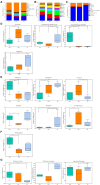Simulated seasonal diets alter yak rumen microbiota structure and metabolic function
- PMID: 36212853
- PMCID: PMC9538157
- DOI: 10.3389/fmicb.2022.1006285
Simulated seasonal diets alter yak rumen microbiota structure and metabolic function
Abstract
Yak is the only ruminant on the Qinghai-Tibetan Plateau that grazes year-round. Although previous research has shown that yak rumen microbiota fluctuates in robust patterns with seasonal foraging, it remains unclear whether these dynamic shifts are driven by changes in environment or nutrient availability. The study examines the response of yak rumen microbiota (bacteria, fungi, and archaea) to simulated seasonal diets, excluding the contribution of environmental factors. A total of 18 adult male yaks were randomly divided into three groups, including a nutrition stress group (NSG, simulating winter pasture), a grazing simulation group (GSG, simulating warm season pasture), and a supplementation group (SG, simulating winter pasture supplemented with feed concentrates). Volatile fatty acids (VFAs) profiling showed that ruminal acetate, propionate and total VFA contents were significantly higher (p < 0.05) in GSG rumen. Metagenomic analysis showed that Bacteroidetes (53.9%) and Firmicutes (37.1%) were the dominant bacterial phyla in yak rumen across dietary treatments. In GSG samples, Actinobacteriota, Succinivibrionaceae_UCG-002, and Ruminococcus albus were the most abundant, while Bacteroides was significantly more abundant in NSG samples (p < 0.05) than that in GSG. The known fiber-degrading fungus, Neocallimastix, was significantly more abundant in NSG and SG samples, while Cyllamyces were more prevalent in NSG rumen than in the SG rumen. These findings imply that a diverse consortium of microbes may cooperate in response to fluctuating nutrient availability, with depletion of known rumen taxa under nutrient deficiency. Archaeal community composition showed less variation between treatments than bacterial and fungal communities. Additionally, Orpinomyces was significantly positively correlated with acetate levels, both of which are prevalent in GSG compared with other groups. Correlation analysis between microbial taxa and VFA production or between specific rumen microbes further illustrated a collective response to nutrient availability by gut microbiota and rumen VFA metabolism. PICRUSt and FUNGuild functional prediction analysis indicated fluctuation response of the function of microbial communities among groups. These results provide a framework for understanding how microbiota participate in seasonal adaptations to forage availability in high-altitude ruminants, and form a basis for future development of probiotic supplements to enhance nutrient utilization in livestock.
Keywords: metagenomics; nutrient simulation; rumen microbiota; season; volatile fatty acid; yak.
Copyright © 2022 Yang, Fan, Jiang, Zhang, Basangwangdui, Zhang, Dang, Long and Huang.
Conflict of interest statement
The authors declare that the research was conducted in the absence of any commercial or financial relationships that could be construed as a potential conflict of interest.
Figures






References
-
- Belanche A., Yanez-Ruiz D. R., Detheridge A. P., Griffith G. W., Kingston-Smith A. H., Newbold C. J. (2019). Maternal versus artificial rearing shapes the rumen microbiome having minor long-term physiological implications. Environ. Microbiol. 21, 4360–4377. doi: 10.1111/1462-2920.14801, PMID: - DOI - PMC - PubMed
-
- Bensadoun A., Paladines O., Reid J. (1962). Effect of level of intake and physical form of the diet on plasma glucose concentration and volatile fatty acid absorption in ruminants. J. Dairy Sci. 45, 1203–1210. doi: 10.3168/jds.S0022-0302(62)89597-6 - DOI
LinkOut - more resources
Full Text Sources

